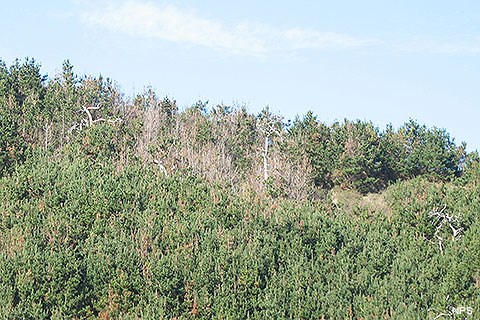
As visitors drive along Limantour Road, they may notice that an increasing number of the bishop pine trees have tan needles at the end of their branches, and some trees are even dying. This is a result of pine pitch canker. Pine pitch canker is a disease caused by the fungus Fusarium circinatum, which was discovered in a bishop pine forest at Point Reyes National Seashore around 2006. This has raised concern regarding the spread of Fusarium circinatum through native stands of bishop pine (Pinus muricata) and other susceptible host tree species beyond coastal California. A 2009 study at San Francisco State University mapped areas affected by pine pitch canker. (1,353 KB PDF) Bishop pine is believed to have once been widespread throughout western North America more than 3 million years ago, but now exists as a relict species situated in discontinuous stands along the Pacific Coast ranging from Humboldt County, California to Baja California, Mexico. As native stands of bishop pine exist in a limited distribution, potential threats to the survival of the species warrant serious attention to protect the biological diversity and ultimately the survival of the species. The fungus F. circinatum, the causal pathogen of pitch canker, causes girdling lesions on branches, stems, and exposed roots of trees, which in turn cause the tree to respond by excreting large amounts of pitch at the lesion site. Causing branch dieback due to obstructed water flow, the excessive pitch at the lesions also attracts engraver beetles, twig beetles, cone beetles, and deathwatch beetles—all of which can attack the tree and cause additional branch dieback. Multiple infections in one tree can eventually lead to widespread dieback of the crown, and ultimately tree mortality. 
How Can Pine Pitch Canker be Stopped?Currently there is no cure for pine pitch canker, although the research continues. The die off of numerous trees raises concerns that increased tree mortality could increase fire risks to communities. Dead and down trees suffering from Fusarium circinatum add significant amounts to fuel loads which previously did not exist. Increased fuel loads could, in turn, lead to increased fire severity. What Can You Do?As a visitor to places with pine pitch canker, please be aware of your surroundings and what you can do to stop its spread. Now that you know the signs of pine pitch canker, be aware of the vegetation around you. When you notice signs that may be pine pitch canker, take precautions such as washing and disinfecting your shoes, tires, and anything that can transport vegetative particles and dirt, similar to what visitors are encouraged to do to limit the spread of Sudden Oak Death. Disinfection can be accomplished with a diluted bleach solution. For more information, download the California Oak Mortality Task Force's A Guide for Recreational Users: Simple Precautions to Prevent the Spread of Sudden Oak Death (603 KB PDF). Wood brought from outside of the park for building a beach fire should be purchased in West Marin. Don't Move Firewood: Buy it where you burn it. Do not bring wood from home. Because pathogens, such as Fusarium circinatum and Phytophthora ramorum, may be found on a large number of trees and other plants and in soil, there are often restrictions on the transportation of these items from areas affected by these diseases in order to limit the spread of this pathogen. When in doubt, do not remove infected material from where it is found. Further details on regulated plants and plant parts can be found at the United States Department of Agriculture's Animal and Plant Health Inspection Service's Phytophthora ramorum/Sudden Oak Death web page. Your County Agricultural Commissioner is one of the best sources for answers to specific regulatory questions pertaining to your area. Spread the word about pine pitch canker and sudden oak death, especially to those who engage in hiking, biking, and driving in and out of infected areas. Pine Pitch Canker between the Coast Trail and Limantour Road: 2010 vs. 2018 

Left image
Right image
|
Last updated: May 7, 2024
